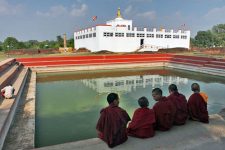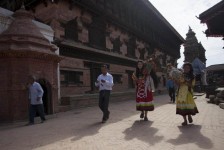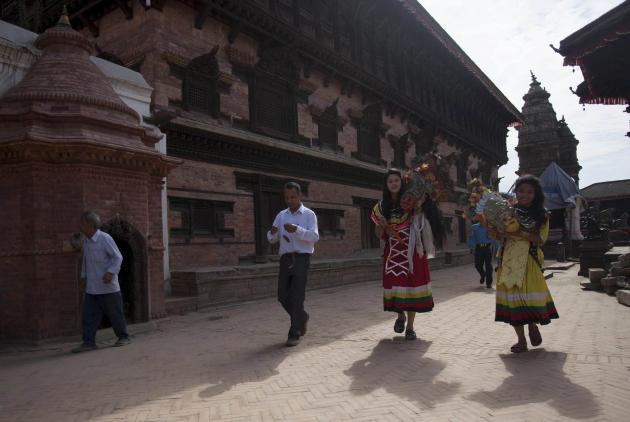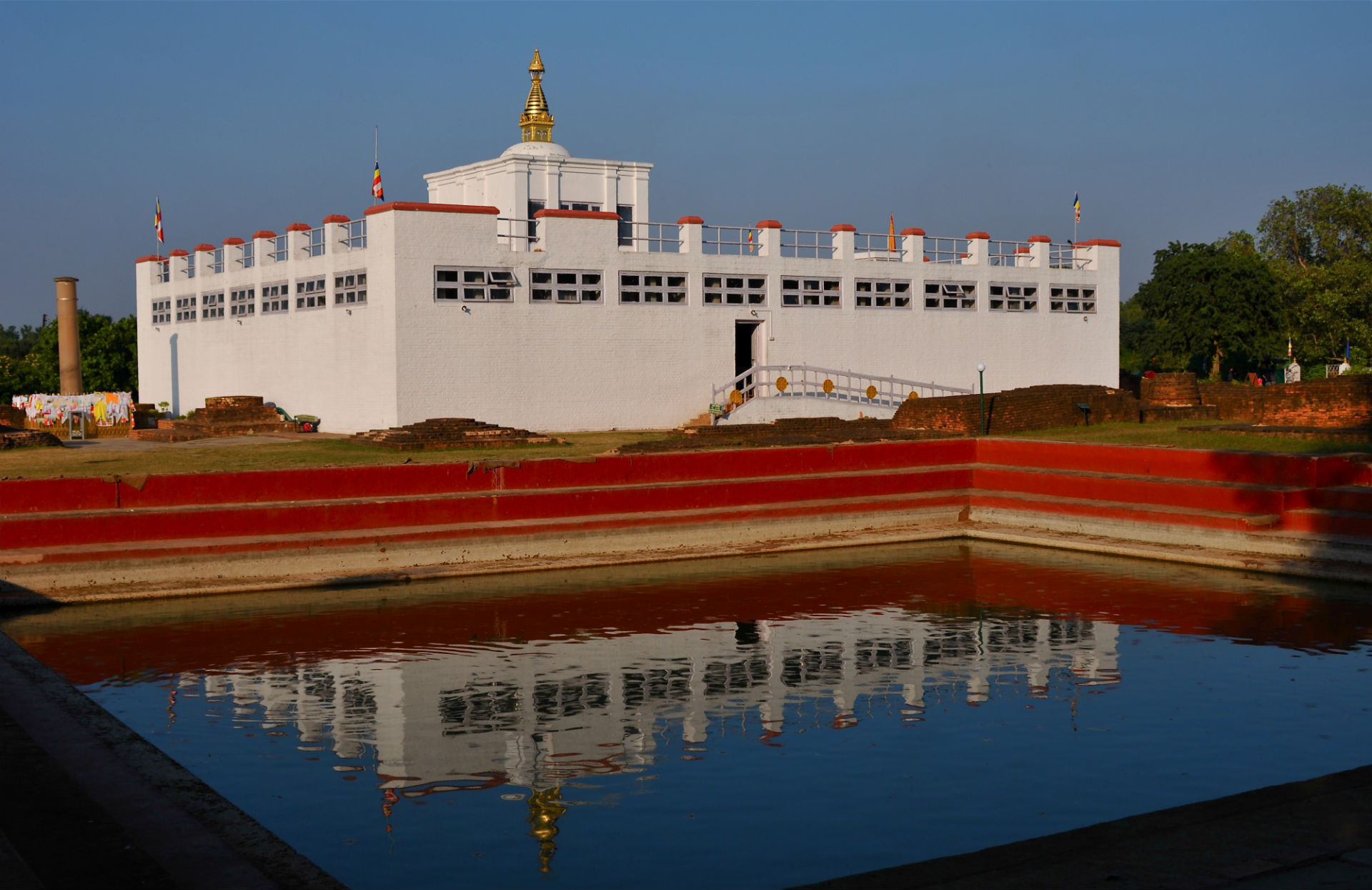

Lumbini Peace Marathon


Lumbini Peace Marathon

Siddhartha Gautama, the Lord Buddha, was born in 623 B.C. in the famous gardens of Lumbini, which soon became a place of pilgrimage. Among the pilgrims was the Indian emperor Ashoka, who erected one of his commemorative pillars there. The site is now being developed as a Buddhist pilgrimage centre, where the archaeological remains associated with the birth of the Lord Buddha form a central feature.
Brief synthesis
The Lord Buddha was born in 623 BC in the sacred area of Lumbini located in the Terai plains of southern Nepal, testified by the inscription on the pillar erected by the Mauryan Emperor Asoka in 249 BC. Lumbini is one of the holiest places of one of the world’s great religions, and its remains contain important evidence about the nature of Buddhist pilgrimage centres from as early as the 3rd century BC.
The complex of structures within the archaeological conservation area includes the Shakya Tank; the remains within the Maya Devi Temple consisting of brick structures in a cross-wall system dating from the 3rd century BC to the present century and the sandstone Ashoka pillar with its Pali inscription in Brahmi script. Additionally there are the excavated remains of Buddhist viharas (monasteries) of the 3rd century BC to the 5th century AD and the remains of Buddhist stupas (memorial shrines) from the 3rd century BC to the 15th century AD. The site is now being developed as a Buddhist pilgrimage centre, where the archaeological remains associated with the birth of the Lord Buddha form a central feature.
Integrity
The integrity of Lumbini has been achieved by means of preserving the archaeological remains within the property boundary that give the property its Outstanding Universal Value. The significant attributes and elements of the property have been preserved. The buffer zone gives the property a further layer of protection. Further excavations of potential archaeological sites and appropriate protection of the archaeological remains are a high priority for the integrity of the property. The property boundary however does not include the entire archaeological site and various parts are found in the buffer zone. The entire property including the buffer zone is owned by the Government of Nepal and is being managed by the Lumbini Development Trust and therefore there is little threat of development or neglect. However the effects of industrial development in the region have been identified as a threat to the integrity of the property.
Authenticity
The authenticity of the archaeological remains within the boundaries has been confirmed through a series of excavations since the discovery of the Asoka pillar in 1896. The remains of viharas, stupas and numerous layers of brick structures from the 3rd century BC to the present century at the site of the Maya Devi Temple are proof of Lumbini having been a centre of pilgrimage from early times. The archaeological remains require active conservation and monitoring to ensure that the impact of natural degradation, influence of humidity and the impact of the visitors are kept under control. The property continues to express its Outstanding Universal Value through its archaeological remains. The delicate balance must be maintained between conserving the archaeological vestiges of the property while providing for the pilgrims.
Protection and management requirements
The property site is protected by the Ancient Monument Preservation Act 1956. The site management is carried out by the Lumbini Development Trust, an autonomous and non-profit making organization. The entire property is owned by the Government of Nepal. The property falls within the centre of the Master Plan area, the planning of which was initiated together with the United Nations and carried out by Prof. Kenzo Tange between 1972 and 1978.
The long-term challenges for the protection and management of the property are to control the impact of visitors, and natural impacts including humidity and the industrial development in the region. A Management Plan is in the process of being developed to ensure the long-term safeguarding of the archaeological vestiges of the property while allowing for the property to continue being visited by pilgrims and tourists from around the world.
Source: UNESCO
Contact Us:
E-mail: sales@samratnepal.com
Phone: +977 – 9851030564


Local artists arrive for a ritual dance as part of the opening of Bhaktapur to tourists at Darabar Square, Bhaktapur. EPA
Following the earthquakes that brought death and destruction to Nepal on April 25 and May 12, the government of Nepal recently assured visitors that Nepal is once again safe and ready to welcome tourists.
Out of 75 districts, only 11 are affected and only three trekking routes remain closed.
“While the damage from the earthquake was extensive, the vast majority of the country was unaffected. The safety and security of visitors is one of the government’s top priorities, as re-establishing the tourism industry is vital to Nepal’s recovery,” stressed Nepal’s ambassador to Thailand, Khaga Nath Adhikari, at the recent “Nepal is Safe: Visit Nepal, Help Nepal” event held at the Holiday Inn Silom Hotel in Bangkok.
Major tourist sites such as Lumbini, Kathmandu Valley, Chitwan National Park and Sagarmatha National Park have not been affected. Popular tourist activities such as trekking, kayaking, ziplining and mountaineering are still operating. The only exceptions are the three trekking routes of Langtang, Manaslu and Gaurishankar, which remain closed.
A strict examination process by expert committees has determined the safety of all affected areas. Any roads or structures that are not safe have been identified and are closed to the public, added deputy ambassador Dornath Aryal.
Thousands of Thais visit Nepal every year. The country does not want this to change and thus is enthusiastically promoting all that Nepal has to offer, such as the unique cultural diversity, beautiful natural scenery and the wide range of outdoor pursuits.
To encourage visitors, many hotels, attractions and agencies are offering discounts, sometimes of up to 50 per cent to help businesses recover. Even the visa office will be working overtime to try and ensure same day visa processing to make visiting Nepal as easy as possible.
The government’s push to promote tourism in the country comes after the earthquake that killed 8,789 and destroyed 511,390 houses and resulted in an estimated loss of 81.25 billion Rs (Bt26.8 billion) for the tourism industry. A second quake on May 12, while not as powerful as the first, is estimated to have killed more than 100 people.
“Despite concerns over continuing aftershocks, these pose no danger and do not indicate any further risk. While tourism will obviously assist with the economic recovery of Nepal, it is also hugely important for our country to return to normal to facilitate the psychological recovery of the its people,” the ambassador said.
Follow and share our more detail from our social media ; Facebook, Pinterest and Twitter.
Source: nationmultimedia.com
Contact Us:
E-mail: sales@samratnepal
On 25th April 2015 an earthquake struck the central region of Nepal in the Gorkha district just north of the main highway between Kathmandu and Pokhara. The earthquake was followed by a number of severe aftershocks and as a result, there were more than 8000 people found dead, thousands more injured and it destroyed houses, trekking trails and monuments including centuries-old palaces and temples listed as UNESCO World Heritage Sites.
Despite damage to some of its historical and cultural monuments and trekking trails, Nepal is now ready to welcome tourists. Some of the monuments in the heritage sites will be reopen for tourists from June 15, 2015. Roads and air transport links remain intact across the country; the majority of hotels and restaurants are in operation. Most trekking areas except Manaslu and Langtang have not been damaged by the Earthquake and trekking can be undertaken any time in these areas. Chitwan, Pokhara, Annapurna region and Bardia also escaped widespread damage, and are thus ready to showcase their abundance of natural life. The birthplace of the Buddha, Lumbini, did not suffer damage and is thankfully all set to welcome visitors back to its sacred soil.
There are many beautiful and captivating cultural and natural sites in the West, Mid-West, Far West and East Nepal that await tourists to welcome there. Out of 75 districts of Nepal, only 14 districts are damaged. Apart from Langtang, Manaslu and Gaurishankar, other 14 national parks and conservation areas including Everest, Annapurna, Kanchanjunga areas withsood the earthquake with strength and power.
The Government of Nepal request international travelers to visit the magnificent and bustling country of Nepal, and support her by visiting it as she attempts to stand proudly on her feet once again. Walk the beautiful trails in the shadow of the most magnificent mountains on earth as you help the Nepalese people reset their course on the path to prosperity. Nepal is now embarking upon the most fascinating period in all of its ancient history, and you could be right there to see it happen and your contribution will be a part of rebuilding new Nepal.
Tourism is one of the mainstays of the Nepalese economy, and Nepal will certainly need the income that tourism brings in as it attempts to recover from this disaster.
Follow and share our more detail from our social media ; Facebook, Pinterest and Twitter.
Contact Us:
E-mail: sales@samratnepal
When Nepal shook under the impact of a 7.8 magnitude earthquake on April 25 followed up by a scourge of a series of powerful aftershocks, the country’s tourism industry was struck with a jolt of an equal magnitude.
The unprecedented setback for tourism in Nepal cannot be immediately scaled nor under estimated for the full impact is yet to transpire, and many are wary of the prospect of tourists returning to Nepal anytime soon. In midst of this confusion-stricken scenario, the government has shown readiness to bounce back and revive the tourism industry to its former glory as it remains Nepal’s mainstay of economy and fame. It is working on a plan to rebuild the destroyed structures at the earliest. The government is all set to reopen access for tourists to the heritage sites from June 15, while it also ramps up its pace to remove the detritus from the collapsed structures. “We urge them (the tourists) to visit our country at the soonest and from June 15 we are reopening access for tourists to heritage sites inside the valley,” Ramesh Kumar Adhikari, Administrative Chief at Nepal Tourism Board said. “They should come to Nepal to continue showering their love to the country and to see the impact of the natural calamity on the beauty of Nepal which also serves as an opportunity for inspection and research”. “We are in grief on the inside and smiling on the outside and to see this they (tourists) should come”, adds Adhikari while pointing out that the damages to Nepal’s beauty is partial and not wholesale. The renowned monuments and temples which constitute the Kathmandu Valley World Heritage Property including many more historically important sites are far from completely perishing. In fact many of the awe inspiring temples and heritage sites are still standing, though they await renovation. The Nyatapola temple also known as the Panch Tale Mandir (Five-Storied Temple) is still unbelievingly erect as if trying to taunt the surrounding inner city of Bhaktapur punctuated by a dismal landscape of shattered houses and twisted ruins. The pagoda-style Nyatapola which suffered partial damage at the top was built by medieval-era King Bhupatindra Malla during a five-month period from 1701-1702. The tallest temple in Nepal stands on five stage plinths designed exactly to withstand such powerful earthquakes. Another temple of Bhairav Nath adjacent to Nyatapola is also relatively intact with a portion at the top edge falling apart. In Patan Durbar Square, the famous Radha Krishna Temple built by the then King of Patan, Sidhi Narsingh Malla in 1637 is intact and ready to welcome the tourists.
According to legend, the temple was carved out of a single boulder whereas another five-storied pagoda style Kumbeshwor temple at Bagalamukhi is still there with partial damage at the top. However, the destruction unleashed by the earthquake in Kathmandu Durbar Square is most severe. Half of the Nautale Durbar (Nine-storied palace), a palace built in the form of a temple, has crumbled while the famous Rana era Gaddhi Baithak built in neo-classical European architectural style suffered widespread damages. The Maju Deval temple, located at the centre, which is usually filled with couples sitting on nine-stage ochre platform and serving as the most popular meeting place has been reduced to debris. Despite this, the secretive and majestic 35-m high Taleju temple built in 1564 by Mahendra Malla is still intact with minor cracks. The temple stands on a 12-stage plinth and is the most precious jewel of Kathmandu Durbar Square.
The Panchamukhi Hanuman Temple which is one of the most beautiful temples in the square is still standing. The residence of the living Goddess Kumari, the Kumari Ghar or Kumar Chowk built in 1957 is also still there to welcome tourists.
The famous Changunarayan Temple, which existed as early as 325 AD in the time of Licchavi King Hari Datta Verma is a masterpiece blend of woodcraft and art in Nepal. The inscription recording the military exploits of King Man Deva who reigned from 490 to 524 AD is the earliest inscription known in Nepal. The temple premises, situated atop a hill at the North-East part of the Kathmandu valley, suffered a wide range of destruction during the earthquake, but the Changu Narayan temple itself escaped destruction but with extensive damages. The temple continues to stand with its artistic richness undimmed.
The Swayambhunath Stupa, one of the oldest heritage sites in Kathmandu valley, is intact although the temples and monasteries in the premises suffered extensive or partial damages. The great Himalayan range wearing the crown of Mt Everest and the picturesque hinterlands of Nepal are not going anywhere.
However, notwithstanding the real situation on the ground, some media have been disseminating alarmist and sensationalized reports in connection to the destruction at multiple heritage sites.
Tourist Guide Association of Nepal (TURGAN) President Hare Ram Baral blamed some foreign media of focusing on only the destroyed temples. “Three of seven world heritage sites enlisted by UNESCO in Kathmandu valley – Swayambhunath Stupa, Changunarayan Temple and Kathmandu Durba Square – have suffered damages but tourist are welcome to see the structures that have remained intact,” Baral said.
He appealed to the media to make people feel secure by informing them of the facts including that many hotels in Kathmandu have been tagged with green stickers. “We have posted information about structures that have not fallen due to the quake in the TURGAN website,” he said adding, “Visit Nepal if you love Nepal.”
“We must be able to tell them that yes we have suffered collapsed structures, but still we have many places where you can visit,” Baral said. Pointing out that Lumbini and Pokhara remained intact, Baral emphasized the only two trekking routes in Manaslu and Langtang areas suffered the impact of natural calamity, but many other trek routes are safe.
“Nepal is one of the countries in the world with multiple dimensions for tourism, while our hospitality and service is highly rated in the world,” NTB administrative chief Adhikari stressed adding, “Tourists are bound to visit Nepal, sooner rather than later.” RSS
Follow and share our more detail from our social media ; Facebook, Pinterest and Twitter.
Siddhartha Hotel Association of Nepal (SHAN), the regional chapter of Hotel Association of Nepal (HAN), is promoting Nepal in Thailand with the slogan ‘Visit Lumbini Help Nepal’. To promote the campaign, tourism entrepreneurs of Lumbini are leaving for Bangkok on June 5.
 According to a press statement, they will be organizing a photo exhibition displaying various places of Lumbini, show a documentary about Lumbini and organize an interaction for promotion of Lumbini with tourism entrepreneurs, media persons and concerted stakeholders in Wat Saket — a popular Buddhist temple in Bangkok.
According to a press statement, they will be organizing a photo exhibition displaying various places of Lumbini, show a documentary about Lumbini and organize an interaction for promotion of Lumbini with tourism entrepreneurs, media persons and concerted stakeholders in Wat Saket — a popular Buddhist temple in Bangkok.